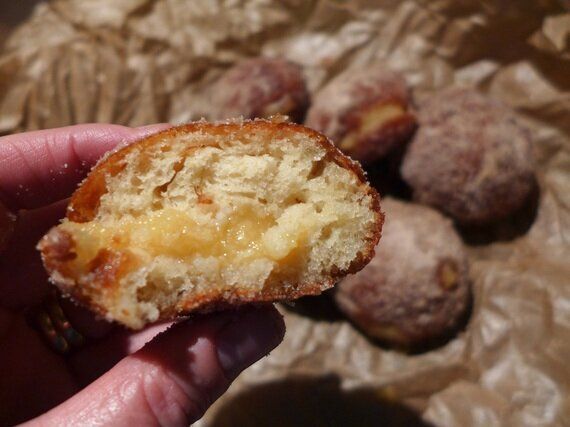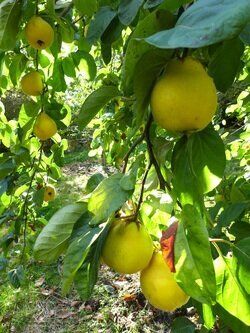
I love quince, it's one of my favourite fruits and I'm always a bit bemused when people say they don't know what to do with them, because they're so versatile. I suppose it's a lack of familiarity: because their shelf life is short, supermarkets tend not to stock them.
Try befriending someone with a quince tree, in a good year they will have so many they'll be glad to find them a good home. Trust me, I know.
You can use them in pies, crumbles and puddings, add them to apple sauce, make pickles and preserves, put them in savoury dishes like tagines ... their aromatic flavour is an asset to many forms of cooking. Just don't try them raw, when they're sour and grainy.
Cooked, they are sensational in these filled, cinnamon-sugared doughnuts. They're a world away from shop-bought, so light you could almost kid yourself they're not fattening. If you can't get your hands on a quince or two, you can substitute apples, preferably a sharp, collapsible cooking variety such as Bramley. (Or even jam.)
I tried a number of recipes and methods before deciding on this one ... some doughs were way too wet to handle. My thanks to veteran US baker Andrew Fink for some good advice which I've incorporated in the recipe.
Quince Doughnuts (makes 8)
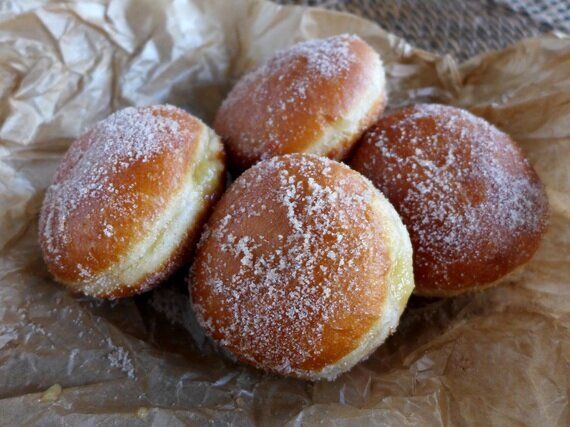
Ingredients for the dough:
210g white bread flour, plus extra for dusting
7g sachet dried fast action yeast
40g caster sugar
1/2 tspn salt
1 medium egg, lightly beaten
100ml whole milk
50g cold unsalted butter, diced
About 1 1/2 litres sunflower oil, for deep-frying
For the cinnamon sugar:
4 tbsp caster sugar
1 tspn powdered cinnamon
For the filling:
400g quince (about 2 fruits)
Around 4 tbsp sugar
Water
Method:
Put the flour, sugar, salt and yeast in a bowl and mix well. On a low heat, melt the butter with the milk. Allow to cool for five minutes, then make a well in the flour and pour it in, along with the beaten egg.
Stir to mix, then knead in a mixer with a dough hook for eight to 10 minutes until smooth and glossy. It should be soft but firm. You can do this by hand on a lightly floured board if you prefer. Although I used a mixer I did give it a couple of turns on a floured worktop to bring it all together nicely.
Place in lightly oiled bowl, cover with cling film and place somewhere warm until it has doubled in size, around an hour. Then divide the dough into 8 pieces and, on a lightly floured work surface, form into balls by pinching the edges into the middle, turning them over and tucking the pinch underneath, turning and tightening as for a bread roll.
Put them on a baking tray lined with baking parchment and dusted with flour, loosely cover with lightly oiled cling film. Leave to rise somewhere warm until doubled in size again, about 45 minutes.

Andrew says the best way to tell if they're proved is to poke the side gently with a finger: if it springs back slowly, they're ready; if it springs back fast, they're under-proved; if it doesn't spring back at all you've overdone it. It's better to err on the side of under-proving in a domestic kitchen than over-prove, otherwise they'll collapse when you lift them to put them in the oil.
While all this is going on, prepare your quinces. Peel, core and slice them, add them to a pan with two tablespoons of sugar and a squeeze of lemon juice, half cover with water and put on a lid. Simmer until soft and collapsing. Taste and add more sugar ... I used another 2 tbsp. Put through a sieve or mouli for a smooth puree, as quince can be grainy.
Mix the remaining caster sugar and cinnamon on a large deep plate. Have ready another plate lined with a couple of layers of kitchen paper.
Once the doughnuts are fully proved, pour the oil into a deep pan to a depth of 5cm (don't fill further than halfway) or use a deep fat fryer. Heat to 160C and, using a slotted spoon, carefully lower the doughnuts into the oil and cook in batches for three minutes a side, until golden brown with a paler ring round the middle. Keep the temperature constant and don't turn them more than once. Chopsticks are handy for flipping them.
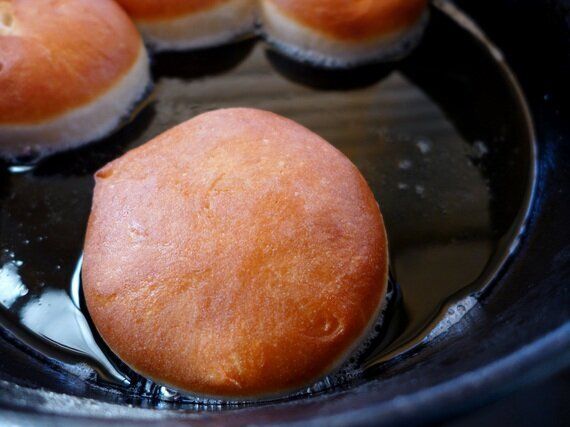
Cooking at this temperature flies in the face of most advice, which suggests hotter oil for a shorter time, but I agree with Felicity Cloake that this way they cook all the way through to the middle. Contrary to expectation they didn't soak up the oil and come out greasy.
Remove, again using your trusty slotted spoon, drain on the kitchen paper and when cool enough to handle roll in the cinnamon sugar.
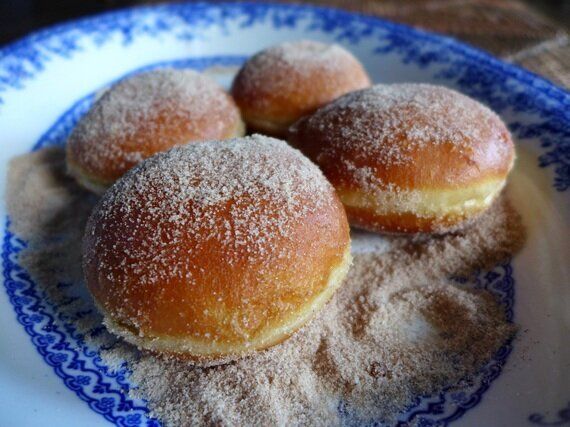
Cut a small slit in the side of each doughnut and using a piping syringe or a piping bag with a wideish nozzle, squirt in about a tablespoon of quince puree.
Eat the same day, ideally while still warm.
